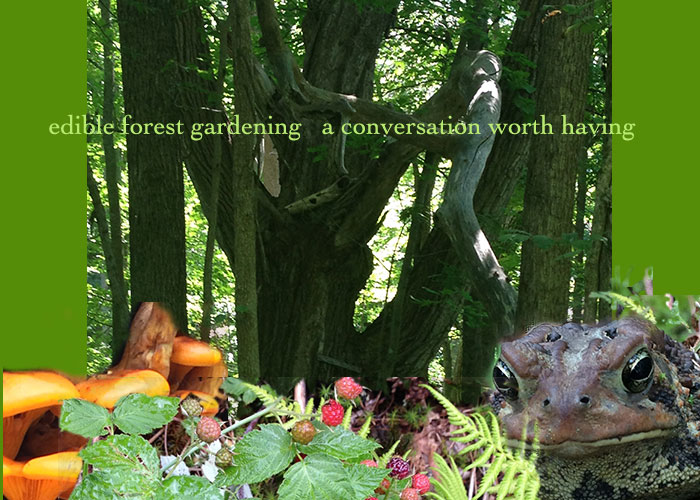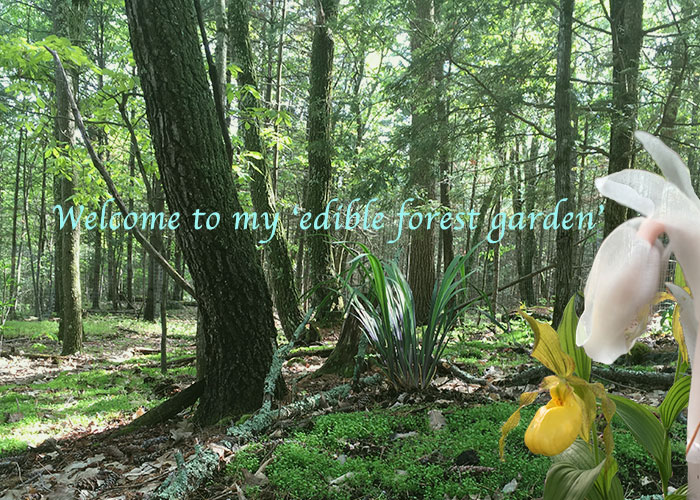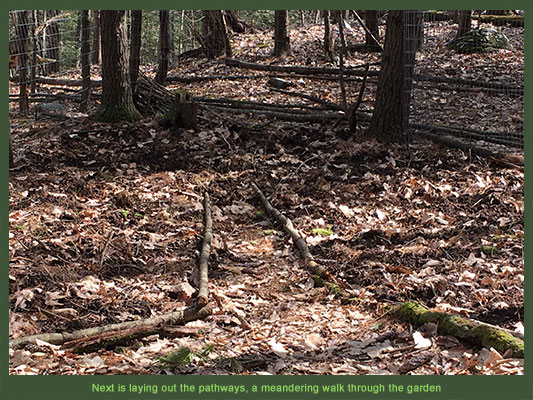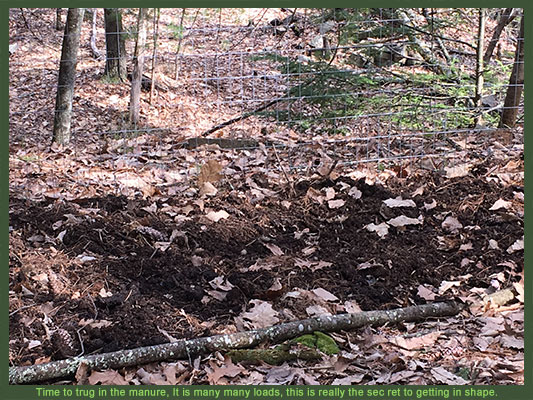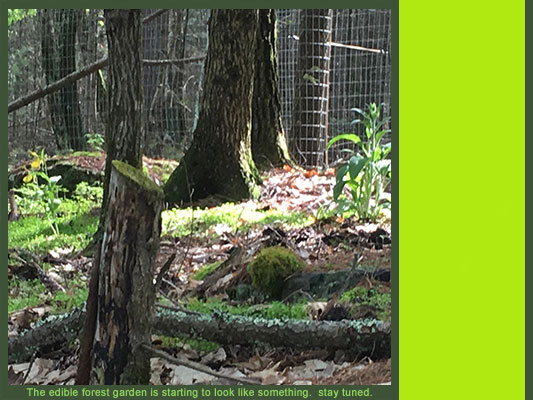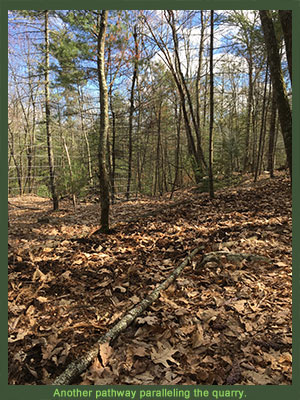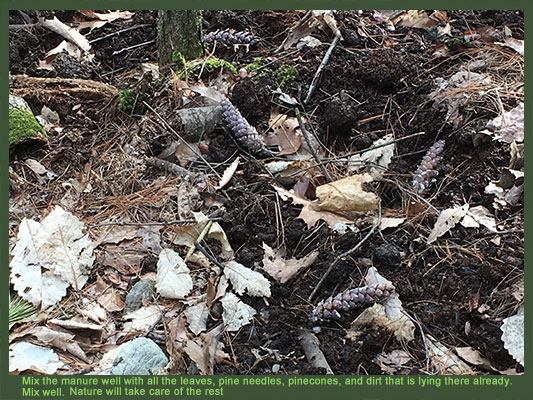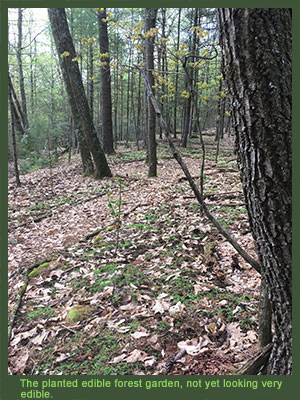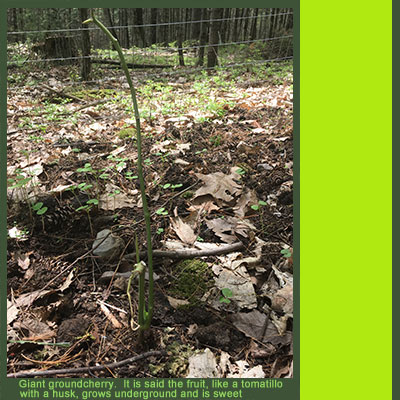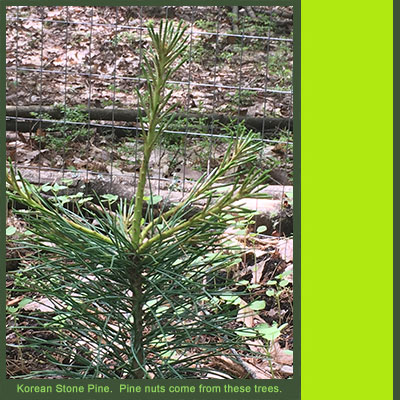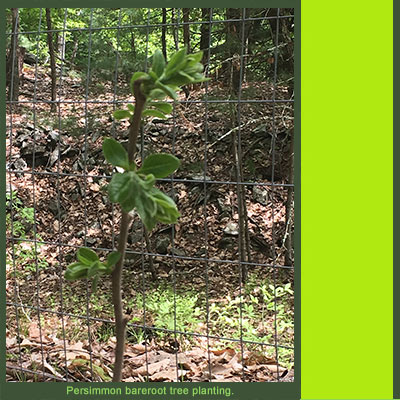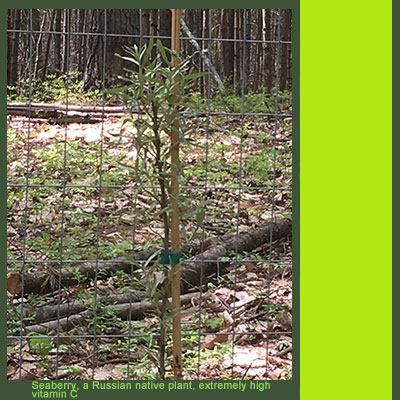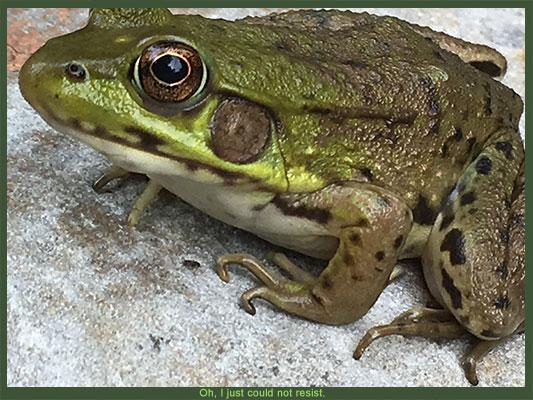edible forest gardening blog
Looking back, where did that initial impulse come from? I suppose you could say, my father instilled the crazy spirit, the love of the forest and the garden, so the natural next step of course, forest gardening and as I love to eat, edible makes sense.
When we first moved to Downey, my father embarked upon his first challenging landscaping project which consisted of turning our front yard into what was considered an unruly disorganized, hardly attractive mess of vegetation, a small yard with a plum, apricot, and two olive trees, grape vines growing along the fence, tomatoes, and other assorted vegetables randomly placed instead of flowers. The yard stood apart from the dichondra and ivy yards that displayed a keen sense of order in our neighborhood.
When my father retired, my parents bought forty-nine acres and he went to work again transforming the landscape, planting two fruit tree orchards and an enormous vegetable garden with compost pile. He planted the hillside with hundreds of bulbs, and dug a pond twenty feet wide by thirty feet long complete with waterfall, fish, and a wetlands beyond. Ten years later and time to reconnect with family, they moved north to Sonoma County in California and once again my father got to work, planting first the backyard until it was very nearly a jungle with arbors and pond, then onto the front yard where he ripped out the lawn, created berms, planted trees. And now here comes the great part, he looked around, realized there was no more land to till, noted the driveway, took a pick axe and got to work. He took out the concrete drive and once that was planted, turned his attention to his neighbors strip of land by the road, left untended. Soon that was planted. When his eyes turned to the local park, he and mom knew it was time to move again. More ponds, more arbors, beautiful stone walkways, and forest like environments.
Two years ago my father passed away and Rolf and I bought land with the inheritance, twenty seven acres in the Catskills, a beautiful forested ridge, with a bluestone quarry running through it. Obvious signs of logging were visible, leaving the detritus and treadmarks of such an operation, old stumps, the rest a mix of large deciduous and pine trees with a clamoring of too many small pines fighting their way to the light and creating an unhealthy environment to thrive in. Excited by the prospect at first of being self sustaining, the vision quickly became so much more. Somewhere, online I came across the book, Edible Forest Gardening by Eric Toensmeier and Dave Jacke and started to read. Within the first few pages I was captured by the vision. It fit so well with my own dream. All they had to do was mention agroforestry, an approach the indigenous peoples were using long before Europeans set foot on this shore. By cultivating a self-sustaining environment that continually renewed itself, by respecting the land using techniques that enriched the soil through natural means, utilizing the local stone to build walls that not only served as retaining walls to build up the soil, but also used to divert water down to ponds acting as reservoirs, these peoples established an ever productive environment that provided for a thriving and large community here in the Hudson Valley. Just a note inserted here, if interested in stone walls and/or our quarry, so much more to write about both, you might want to check out my blog on 'our land' where I go further into detail.
Basically edible forest gardening started in 1981 by a man named Robert Hart in England who decided to care full-time for his disabled brother, and to compensate for the reduced income, created a food garden, what today, at least from photos, resembles a junglelike environment. Although this has been an approach used in the tropics for possibly centuries, this was the first temperate climate experiment. Forest gardens basically involve 6-7 layers, depending on who you talk to, the canopy layer of tall trees providing nuts and timber, the next layer consisting of fruit trees, then berries (considered the shrub layer), followed by the ground cover of herbs, vines wrap the trees or trellis, kiwis and passionflower are the two that come to mind, then under the ground you have the root and tubers. and finally as an optional seventh layer, mycelium, the fine strand weblike network of the fungus organism that we recognize as mushrooms, its reproductive organs.
At this point I should mention that when speaking of forest gardening, it does not actually mean in the forest but rather mimicking the ecology. However with a forest or I should say, a remnant of it, already in place, I see no reason to not utilize its great potential. Now several things come to mind immediately, the most important of course being lack of sun. But as I walk around, there are patches of sunlight everywhere. When a large tree comes down, it does so in an extremely untidy manner, bringing branches and smaller trees crashing down as well, All that matter breaks down and decomposes eventually into rich soil for new growth. In the meantime it provides an area of sunlight, a perfect site for starting a forest garden. but wait, before moving on there is another issue that comes to mind immediately, the lack of nitrogen in the soil. This may be another reason the forests are not nearly so healthy as they once were. Passenger pigeons had until this last century, existed in vast numbers, in the billions, their flocks covering vast tracts of land for days as they flew overhead. At night they would roost in the forest and make thick ground cover of their nitrogenous poop, riches to the soil. With guns, the passenger pigeon was destined to extinction and we lost a great valuable asset to agriculture. Lastly, at least for the moment, i have concerns about the voracious eating habits of the deer which have rapidly increased their population due to lack of predators so fencing and how much, becomes an issue.
So where are we in all of this. Start first with enthusiasm, and read as the urge or questions arise. One can spend too much time in the pages of it, but feeling the soil, getting to know and love it is key. I am just learning so this is not about expertise, rather it is an invitation to join a conversation and learn from mistakes I and others make along the way, whatever success, I am thrilled and happy to pass along.
Last spring, was I guess you could say, the start of it, the edible forest garden. Of course this was not the first time I have ever planted plants or cast seeds, but on this scale, with this set of parameters, nothing close. I am essentially a neophyte in this grand experiment. Cleaning the forest, enough to see the potential became a first step to making sense of how to approach this project. My husband, Rolf, had made a road into our property, 2000 feet long and beside it had dug a five foot trench for the electrical and cable lines. This involved taking out trees and of course disturbing a wide swath of forest floor. Did you know, as I now know, that underneath the ground, the tree roots graft, communicate, and nourish each other. At one time it is believed that much of the country was connected by a giant rootball. Imagine that! At first glance the road looked beautiful, the trench was neatly covered over, but the surrounding area looked so forlorn, however with a lovely surprise, more sunlight for growing. So I set to work cleaning up. Moving rocks to the side, I learned how to dig postholes that surprised even Rolf. Since our ground is so rocky, I found by using water to wet the ground and one of those six foot iron poles, I could pound the pole into the ground and by pushing and pulling could loosen the ground enough to pull up the rocks and eventually dig down three feet. I then took four to six inch diameter tree trunks, oak, placed them in the holes, and filled with dirt, stones, and rock, pounding every few inches until at ground level, it became a great source of pride that the posts are solid standing. Then taking welded fencing eight feet high to deter deer, I wrapped the perimeter. At this point I was ready to start my first garden, not really in the forest but at the very periphery, so shade still a consideration. Now the point of forest gardening is to be able to forage throughout the year in your yard for edibles and not have to work particularly hard once the garden is mature. And why is this? Because it relies for the most part on perennial plants. So with that in mind, and I am all for ease, I prepared to plant. My soil is heavily clay, at least the disturbed part, so I determined to refrain from digging any more if at all possible. We had a dump truck load of compost brought in, I bought several bales of hay, and had several loads of topsoil brought in. I think for a first year, it worked well. I planted twenty crowns of asparagus, three paw paws, two filberts, seven black currants, four kiwis, a fig, and a small patch of lettuce, kale, and delicata squash. Eventually, once our shipping container home is up, we hope to put the seasonal vegetable garden on our green roof so we will no longer have to worry about the voracious appetite of nature.
Along the drive I planted another seven fruit trees, four pears, a peach, and two plumcots, all decimated by the Japanese beetle and the deer until I put up two fenced enclosures, this time with metal stakes and the black deer netting, which I have to say, is not recommended for longevity. Over the winter, the netting sags from snow, putting weight on the heavy metal stakes and gradually they slump providing better access for the deer. In the Spring, I will have to come up with a better solution. In spite of this problem, what a difference having a fence up meant. Suddenly the trees sprang to life, their branches growing rapidly and filling out to such a degree, I can only imagine, had I protected them from the start, where they would be. It is, at this moment I make the disclaimer. I do not believe in any form of pesticide. I believe if nature is in balance it is well equipped to deal with any problems that emerge. Of course, it is not always on human time, and so there is the problem of people reaching for the short term intervention before the trees have had time to respond to the assault. I chose to pick the beetles off the leaves as best I could for this year and plan on chickens this upcoming spring to take care of the beetle larvae which they love to eat.
Early on, I planted a small garden of berries, not realizing that blueberries are native here. Not that I have seen many berries yet, but sometime during the summer as Rolf looked into the quarry, he said, I think those are raspberries down there, and indeed they were. A profusion of raspberries and an overgrown bush of blackberries with what appeared to be, hundreds, maybe thousands of berries. Never have I seen such a dense delicious opportunity waiting to be picked.
With Fall, came preparations not only for Winter, but for the upcoming Spring. I wanted to really kickstart the growing season by improving the soil, and since we had recently become friends with Adam, who oversees a horse farm down the road, we suddenly had a great unlimited source of manure to improve the soil. At the same time, he had the source for organic hay so we bought twenty bales plus another ten from our local source. I was set. Throughout the summer I had been busy in the woods, continuing to take down the saplings with my loppers, leaving only the healthiest for the future. Then it became obviously apparent at some point that I needed to have my own chainsaw, I wanted to take some of the three to four inch diameter trees that were dead out as well, and a manly chainsaw is simply too heavy. A good chainsaw, a Stihl, is a must as well as a focus on keeping the chain well oiled and sharp. Rolf has been using them his entire life and I rely on his great expertise in this and for all our equipment. We bought a wood chipper early on, a Woodmaax, an excellent and reasonably priced indispensable part of our being able to do this project. At first I took the trees down and pushed them through the chipper, then spread the chips on the ground. In the summer I realized that taking all the branches off the trunks, breaking and spreading them would most likely serve the forest well. The branches litter the floor of the forest, break down slowly and release nutrients back into the ground for the trees. I continue to spread the chips, Fall arrives and the blizzard of leaves. With the winter snow and rain this year, i am hopeful and excited to see what has done well.One more point to make before stepping back for a moment. Once we realized buying manure by the bag, ten dollars for a ten pound bag, became laughable when considering the amounts that would be necessary, we talked with Adam of the horse farm, and decided to get fifteen dump truck loads. And here, another equipment story, we needed a dump truck. as noted in one of my blogs, our tendency is to leap into the great unknown at every opportunity. You just never know. So it was with our dump truck. We saw it online, the place looked semi-reputable, a website with sparkles and a 1956 chevy animated. how could one go wrong. It was outside Springfield, Massachusetts, a three hour but more likely five hour, we took the scenic backroads, which I have to say, towards the last hour became barely endurable, and then when we arrived at the spot we could hardly believe our eyes. Had it not been for the truck sitting there, we would never have guessed that this wasteland with a terminal junkyard could possibly be the place. But as we stood there looking the truck over, we were approached by one of the salesmen and directed to the trailer. Inside were the other junkyard men sitting on a badly worn, slick with grease, couch and the men themselves in their greasy jackets and sullen expressions did not lend to the levity of the situation. Looking around I knew I would have to be the first to speak. Hey, I know a show you might like. It is called, 'Highway Through Hell'. Immediately the three fired up their mental engines and got excited. Oh they knew that show, why, they knew Jamie, the owner of a tow truck operation outside Vancouver in British Columbia and the lead of this show. Suddenly we were on best friend terms. It turned out that there was a reason why the site looked so wasted. Probably the only tornado in the last hundred years on the East Coast, had touched down directly on their building blowing it to smithereens, and they had the framed newspaper front pages to prove it. The dump truck had 24,000 miles and was as clean as could be for only 2400 dollars, less than most cars. I could hardly believe our luck. Rolf drove it back, I followed in the car. They called a week later to make sure he had made it back here, I think they expected it to collapse along the way. We were so lucky! And what a workhorse it has turned out to be. Just picking up and dumping the first fifteen dump loads of manure makes it a family heirloom.
Now what I have noted while working in the forest, is that when the trees fall, they often form readymade planting beds in varied shapes, square, triangular, natural places to fill with manure, branches, leaves, chips to compost over the winter in time for Spring. Will let you know how that goes.
Time to pull on the jeans, heavy socks, undershirt, thermal long sleeved shirt, hoody,my patagonia down jacket, with ever growing duct tape to staunch the hemorraging flow of feathers, work gloves, and most importantly a knitted hat because it is no joke about being hot headed. I definitely feel much colder, prone to the deep freeze of winter without it. And finally, the last necessity, work gloves, again wrapped in duct tape, I probably buy a pair a week during the growing season, wearing them thin and the tips to nubs, pulling, poking, jamming, cutting, breaking, yanking, digging, and pushing, dirt, trees, plants, fencing, rocks, and tools. It is what I do. And I love it. But this is still to come.
At the moment it is 2019, and just turned February. I detour for a moment to reflect, Spring, seems to be coming a month later for the last five or so years. In my reading, I discovered that the Inuit noted the North Star was no longer located directly above, which caused them concern as they hunted using the star for location. Well, scientists here, scoffed, at first. Then they took a look, and indeed the Earth was off by fifteen degrees, certainly nothing to scoff at. Depending on which way the Earth rolled, that would most likely affect our seasonal change. And almost to the day, April now turns to Spring around the 21st. So do not jump too soon to plant, because, summer is also longer at the end, as is Fall. It is a whole new climate changing world.
Now I take a step back, actually wade in to the past of 2017 with my mukluks on, barely hanging together after five years of heavy wear. I would duct tape them, but the mud and water easily warp, twist, and dampen the tape making it impossibly useless. Someone mentioned that the county has a dollar a tree program every year, you order in January to March, and pick up your twelve to eighteen inch leafless, barefoot, starters in April. Sugar Maples, White Paper Birch, River Birch, Lilacs, Serviceberry, Juneberry, Flowering Dogwood, and Scotch Broom. I purchased seventy-five. I looked at my new aspiring trees and bushes, with a vision of them in full stature, excited at the prospect of diversifying our land for a third of my monthly phone bill. Carefully I located their new homes spread across the property and spent an entire day planting. It did not take long until the deer noticed that I had provided appetizers for them. They called in their friends and family. Within a month nearly all the trees were eaten. I should have known better. I thought they would be passed over as insufficiently small and innocuous, hardly worth consuming. After all, the forest is filled with blueberries, mushrooms, raspberries, green exploding across the landscape, so why would they want such tender young plants, to brush their teeth? Two years later, out of the 75, I would guess that I still have perhaps ten left, mostly because I put up fencing in areas that included the trees. The deer still roam, graze and enjoy the land, and we most definitely love watching them linger, eat, and make themselves at home. But certain areas are off limits, not that it always works. This last year, 2018 was a big planting year, and a year where our first harvest of the fruit trees planted two years ago, looked ready for the picking. Of course that was the night before. We took a bite of the tender, juicy flesh of the plumcot and the sweet juice of the asian pear, deciding one more day would bring out the full delicious flavor. Next morning with trugs in hand, I went down to pick the fruit only to find it was neatly harvested in the night. The plumcot had not a leaf out of place. The branches were perfect, with the exception that all the glorious fruit was missing. Squirrels. The asian pear had a major broken branch, all the fruit missing, and the deer fencing, neatly sliced all the way down, as if scissors had been used to cut the eight foot length. Raccoons. These early lessons, frustrating initially, are ultimately terrific learning experiences going forward. Once the trees mature into their height and bounty, I have high hopes to be able to share. With thirty-seven fruit trees and many berry bushes, it seems there should be plenty for all of us.
Which brings me to last year planting. Trees. A big year for fruit trees, another twenty-two, bringing our total to thirty-seven. I have apple, pear, peach, asian pear, plumcots, cherry, paw paws, persimmons, and mulberry. I planted grapes, strawberries, ground nut, maypop, an asparagus bed, blueberries, gooseberries, elderberries, sea berries, kiwis, honeyberries, and filberts. The list goes on. What they have in common is they are perennials meaning they have a lifespan, often over many years. Originally perennials were favored in cultures around the world. But with the advent of industrialized farming, you could get greater production out of mono cropped annuals. Unfortunately, this created the massive problems we have today. Chemical fertilizers that have been overused so farmers could continue to grow the same mono crop year after year, often on vast tracts of land, subsidized by the government, not to grow for our population but for export overseas. The runoff from the fertilizers into the water has polluted our rivers making them toxic for human consumption. Now the corporations have genetically engineered sterility into the seed so the farmer is forced to buy it every year. Most of the small farmers are squeezed out, can not make a living using their traditional methods. But there is reason to hope. The sustainable farming movement, using methods that have been used for centuries, permaculture, and the edible forest movement, draw on the wisdom from indigenous cultures and traditional methods that increase fertility, build soil, and create compatible growing groups that nurture and protect each other and the earth. It is an exciting time to be involved in healing the planet and working to create a symbiotic relationship with it.
Reading my writing is a bit like a Sunday drive meandering through the countryside, stopping here , exploring there, a quick swivel of the head to capture the light on a leaf, or a tiny salamander under a stone.
The landmark, really, for me this past year was creating my first forest garden. My other gardens, ranging along the periphery of the forest are done in the model of the edible forest garden as first conceived by Robert Hart (see above), whereas this is my first foray into planting within the forest, using the canopy cover for plants preferring partial shade while planting the sun lovers in areas where the forest has opened up exposing more sunlight. I put up fencing, I took out dead saplings, we had a terrible Southern Pine Beetle blight that came through in 2016 wiping out most of the younger and midsize growth. Horrifying at first to witness our beautiful forest so devastated, I got to work, with loppers and chainsaw, cutting out the dead trees leaving the healthy and larger trees. Over the last two years, the results have been remarkable. There is a rebound of young seedlings springing from the earth, and the larger trees are growing new branches, expanding and becoming healthier. I initially chipped the wood and spread the chips over the forest floor. Then I thought about it and realized that breaking the branches would provide better long term decomposition and slower consistent nutrition to the roots. With the tree trunks, I have created terracing down the slopes of the land. I have 22 dump truck loads curing over the winter that I got in the Fall. I will be transferring this to the terraced areas to incorporate nitrogen into the soil. Then I plan to seed it with white new zealand clover, a perennial ground cover and so the process begins, more trees, berries, plants to hold the soil and feed us.
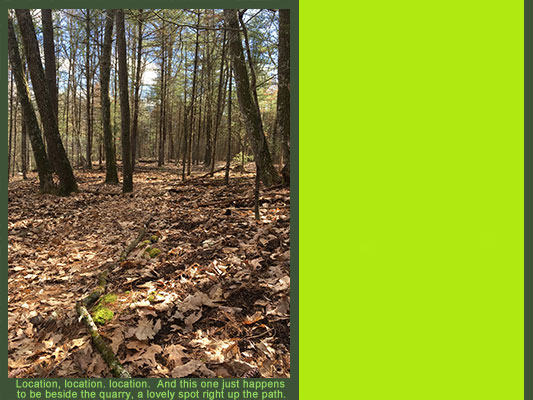
|

|
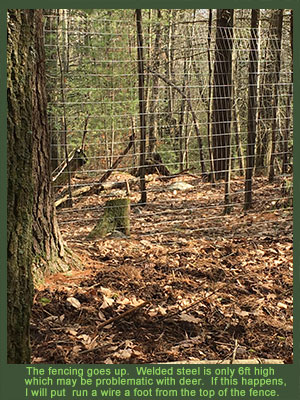
|
As for the enclosed area of the forest, it is an experiment in what works. Some areas have good sun during half of the day while there are definitely shady spots to work with. Once I cut out the deadwood, I set out pathways, creating planting areas around the existing trees. Believing it better to leave the soil intact as much as possible, I brought in many trugloads full of manure and spread it around, seeding it with clover. Then I planted my garden. I chose mashua, a peruvian tuber, with many varieties, related to the potato, for along the wire fencing. I planted my cherry trees, persimmons, Korean Stone Pine, plum trees intermixed with the trees already there. I also planted blueberries, elderberries, honey berries, seaberries, and Akebia, a Japanese exotic, that sounds quite interesting. Columbine, comfrey, iris, ginseng, solomon seal, and japanese anemone to name a few, add beauty to the garden. So far much of it did well. The seaberry (male) has not thrived and a local botanical garden assured me that they have had little success with this plant. I planted a Fuki, and although it struggled to survive, I had disregarded the information which came with it, stating that it does well in a wetter sunnier location. If I see it emerge in the Spring, I will hastily move it elsewhere.
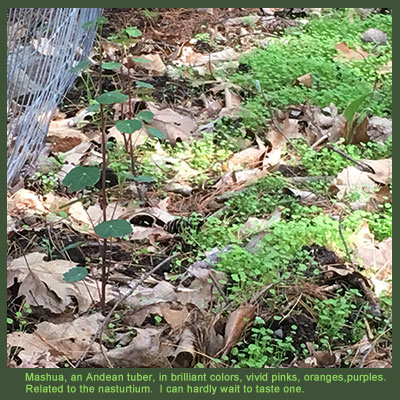
|

|
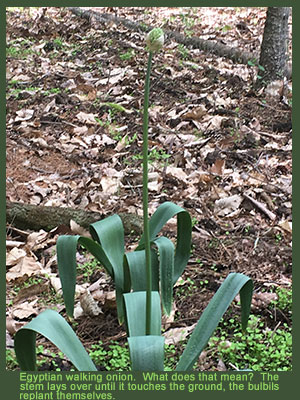
|
So for now, moving into the Spring ahead of 2019, starting to look at perennial catalogues and dreaming of spectacular gardens ahead. This promises to be a huge year, as we complete the greenhouse, Rolf deserves the huge credit for that (see the greenhouse blog) I have created ten gardens to date, and plan to focus on at least another four to five within the woods, as well as getting all the terracing filled with manure and clover. It is an ambitious dream as Rolf and I will be putting great effort into pouring a foundation and getting the studio built, priority one. So stay tuned. Oh, and this is the year for putting our solar.panels into place Breathless.





